14 Results with the "Romantic Melodrama" genre
Adventure Fiction (1164)
Biography (435)
Business & Finance (1)
Children's Literature (124)
Comics (6)
Culture (51)
Drama (123)
Dystopian (29)
Fable (86)
Fantasy (1132)
Fantasy (203)
Fiction (1010)
Finance (1)
Gothic Fiction (12)
Historical Fiction (615)
History (122)
Horror (56)
Lifestyle (36)
Literary (404)
Literary Fiction (207)
Memoir (113)
Mystery (422)
Non-fiction (87)
Novel (549)
Paranormal Fiction (96)
Philosophical (182)
Philosophy (45)
Poetry (249)
Political Fiction (14)
Politics (42)
Practical (32)
Psychological (4)
Psychological Thriller (108)
Relationship (6)
Romance Novel (716)
Satire (91)
Science (46)
Science Fiction (345)
Self-help (68)
Society (65)
Society (2)
Spiritual Growth (1)
story (2)
Thriller (704)
True Crime (56)
view (11)
Women's Fiction (2)
Young Adult (233)
-
Chapter
Scene II — The Lady of Lyons
 Scene II of The Lady of Lyons reveals a turning point where emotions are no longer restrained by social expectations, but instead, rush forward with urgent clarity. Pauline, caught between love and obligation, prepares to sacrifice her happiness to preserve her family’s dignity. Though surrounded by opulence and outward reassurance, she cannot ignore the emptiness that shadows her decision. Her marriage to Beauseant, arranged to rescue her father from disgrace, feels less like a noble act and more like a…
Scene II of The Lady of Lyons reveals a turning point where emotions are no longer restrained by social expectations, but instead, rush forward with urgent clarity. Pauline, caught between love and obligation, prepares to sacrifice her happiness to preserve her family’s dignity. Though surrounded by opulence and outward reassurance, she cannot ignore the emptiness that shadows her decision. Her marriage to Beauseant, arranged to rescue her father from disgrace, feels less like a noble act and more like a…-
47.9 K • Ongoing
-
-
Chapter
Introduction
 Introduction to Aucassin and Nicolete begins not with lofty claims, but with quiet distinction. This poetic work, unlike many literary relics from the same era, has endured across centuries without losing its charm or originality. Blending prose with verse, it introduces a narrative form called the cante-fable, which doesn’t merely tell a story but performs it. Where most medieval texts lean toward morality tales or courtly grandeur, this piece feels more personal, intimate, and occasionally ironic. It…
Introduction to Aucassin and Nicolete begins not with lofty claims, but with quiet distinction. This poetic work, unlike many literary relics from the same era, has endured across centuries without losing its charm or originality. Blending prose with verse, it introduces a narrative form called the cante-fable, which doesn’t merely tell a story but performs it. Where most medieval texts lean toward morality tales or courtly grandeur, this piece feels more personal, intimate, and occasionally ironic. It…-
12.1 K • Ongoing
-
-
 The Song-Story of Aucassin and Nicolete ends not in tragedy but in fulfillment, with love triumphing after trials that tested its depth. Nicolete, having endured separation and hardship, takes it upon herself to prepare for a reunion not just with words but with grace and presence. She bathes, rests, and seeks out healers and herbalists, those wise in the secret arts of roots and oils. With their help, she creates a salve, one touched by tradition and healing lore, which makes her skin gleam with renewed…
The Song-Story of Aucassin and Nicolete ends not in tragedy but in fulfillment, with love triumphing after trials that tested its depth. Nicolete, having endured separation and hardship, takes it upon herself to prepare for a reunion not just with words but with grace and presence. She bathes, rests, and seeks out healers and herbalists, those wise in the secret arts of roots and oils. With their help, she creates a salve, one touched by tradition and healing lore, which makes her skin gleam with renewed…-
12.1 K • Ongoing
-
-
Chapter
Notes
 In this notes "THE BLENDING"--of alternate prose and verse--"is not unknown in various countries." Thus in Dr. Steere's Swahili Tales (London, 1870), p. vii. we read: "It is a constant characteristic of popular native tales to have a sort of burden, which all join in singing. Frequently the skeleton of the story seems to be contained in these snatches of singing, which the story-teller connects by an extemporized account of the intervening history . . . Almost all these stories had sung parts, and of some…
In this notes "THE BLENDING"--of alternate prose and verse--"is not unknown in various countries." Thus in Dr. Steere's Swahili Tales (London, 1870), p. vii. we read: "It is a constant characteristic of popular native tales to have a sort of burden, which all join in singing. Frequently the skeleton of the story seems to be contained in these snatches of singing, which the story-teller connects by an extemporized account of the intervening history . . . Almost all these stories had sung parts, and of some…-
12.1 K • Ongoing
-
- Previous 1 2
